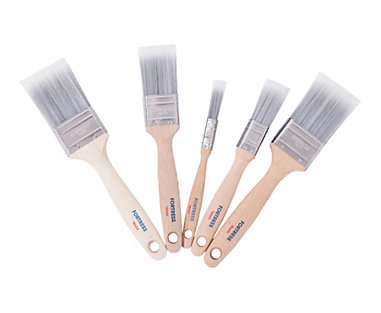You’ll just need to thoroughly sand and clean the walls before painting them. You could be using the wrong paint or brushes. Later on, I’ll talk about the types of paint that exist and the appropriate brushes you should be using with them. Usually, thicker paint is to blame for brush marks, so you may also need to use a paint additive. Most people prefer a roller or sprayer over a paint brush because of the extra time it can take to properly cover a surface. A large four inch paint brush, however, can cut this time almost in half while still offering the unique finish smaller brushes provide.


Once you learn how to choose the right paintbrush based on the type of coating you’re using, you’ll want select a paintbrush that will “fit” the surface you’re painting. Below are some general guidelines to help you.
Most paintbrushes range in size from 1-inch up to 4-inches and can have an angled or flat/straight edge. The edge of the brush is basically a matter of user preference, but the different sizes are important to consider based on the surface you’re painting.

Large brushes (3-inch to 4-inch) will hold more paint and cover a larger surface area, which helps you to finish your project faster. These brushes are ideal for exterior siding, decks, doors, or walls.

When you have tight, detailed areas to paint, a small brush (1-inch to 1½-inch) is recommended. Adding an angle sash can also help you get into those hard to reach crevices. Small brushes are ideal for hobbies and crafts, window mullions, and tight corners.
Brushes that are 2-inches to 2½-inches are a great middle ground. They are typically the most popular and versatile brushes because they can be used for such a wide variety of projects. A flat brush of this size is ideal for baseboards, cabinets, furniture, moldings, railings, shutters, and gutters while an angle sash brush of this same size is effective for window frames, casings, door moldings, and cutting in edges of walls, ceilings, and baseboards.
Thin Paint Brush For Walls With Acrylic Paint Paint

It is common for people to think small brushes are easier to control. This isn’t always true! If you select a high-quality brush in a slightly larger size (2-inch instead of 1½-inch), it can paint more precisely than a low-quality, smaller brush. The paint project will go much faster and the finish will be smoother, too. However, it’s important to note that if you’re a beginner, you need to be careful. Attempting to trim around your woodwork without taping it off can be tricky, so consider starting with a thin angle sash style brush instead of an angle sash. This will help you control the amount of paint you’re carrying to the wall and avoid the possibility of ruining your woodwork.
How To Thin Paint For Walls
Now that you have your perfect paintbrush picked out, learn how to load it.
The Wooster Brush Company offers quality brushes for every project. To help you select the perfect brush, visit our Paint Brush Advisor. If you have additional questions or need more information, please contact our Customer Service Department.
